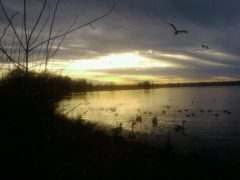We can thank Franklin D. Roosevelt for many of the improvements we enjoy today at White Rock Lake. Under Roosevelt’s New Deal, the Civilian Conservation Corps was organized to put Americans back to work after The Great Depression. White Rock Lake benefitted from this program. Two hundred previously unemployed young men from Dallas, Tarrant, and Collin counties lived in barracks along the eastern shore and worked seven years to construct Flag Pole Hill, Sunset Bay, Big Thicket, and Winfrey Point. They planted and transplanted many of the trees still shading the park.
If White Rock Lake could talk, oh the stories she would tell.
Perhaps she would weave woeful wartime stories. During WWII, White Rock Lake was a German prisoner of war camp, housing over three hundred captives.
Perhaps she would spin yarns detailing afternoons spent swimming and picnicking on her sandy beach. For years, White Rock Lake provided an escape from the relentless, un-airconditioned summer heat. Swimming apparel and towels were available for rent. A floating barge provided dancing under the stars.
Perhaps she would discuss life at the lake when her barracks became overflow housing for Southern Methodist University students attending college on the G. I. Bill after the war.
But lo-o-o-ong before any of this, White Rock Lake wasn’t even a lake.
In 1890, Jacob Buhrer, a Swiss immigrant, purchased 200 acres of pasture for his herd of sixty-five dairy cows. Buhrer’s Swiss Dairy Farm delivered fresh milk two times a day to East Dallas residents, dipping milk from buckets straight from the wagon. As Dallas expanded and her water demands grew, Buhrer’s land was purchased in 1911 for the construction of White Rock Lake. What remains of his dairy farm lies underwater, a story more intriguing than the “Lady of the Lake” Halloween tale…
Not that long ago, my life revolved around White Rock Lake. Literally. Not because I was a dedicated runner or an Arboretum volunteer. Not because I rowed or hiked or sailed. Every day for years and years, I drove up and down Garland Road to children activities including soccer, orthodontia and scouting. White Rock Lake was the site of many hard earned merit badges as well as trips to Boy Scout Hill for Saturday morning, hand-made, kite-flying.
Although frantic and overbooked, the mere sight of the lake injected a bit of peace.
Today, the lake offers amenities including Audubon-designated bird watching and wetlands, fishing piers and hiking/biking trails. It’s difficult to imagine prisoners of war and grazing cattle. The next time you stroll around the lake or admire the breathtaking sunrise from Garland Road, take a moment to consider the life of White Rock Lake before your own reality.






